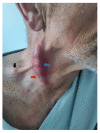Vector-Borne Tularemia: A Re-Emerging Cause of Cervical Lymphadenopathy
- PMID: 36006281
- PMCID: PMC9412492
- DOI: 10.3390/tropicalmed7080189
Vector-Borne Tularemia: A Re-Emerging Cause of Cervical Lymphadenopathy
Abstract
Tularemia is a zoonosis caused by the highly invasive bacterium Francisella tularensis. It is transmitted to humans by direct contact with infected animals or by vectors, such as ticks, mosquitos, and flies. Even though it is well-known as a tick-borne disease, it is usually not immediately recognised after a tick bite. In Slovenia, tularemia is rare, with 1-3 cases reported annually; however, the incidence seems to be increasing. Ulceroglandular tularemia is one of its most common forms, with cervical colliquative lymphadenopathy as a frequent manifestation. The diagnosis of tularemia largely relies on epidemiological information, clinical examination, imaging, and molecular studies. Physicians should consider this disease a differential diagnosis for a neck mass, especially after a tick bite, as its management significantly differs from that of other causes. Tularemia-associated lymphadenitis is treated with antibiotics and surgical drainage of the colliquated lymph nodes. Additionally, tularemia should be noted for its potential use in bioterrorism on behalf of the causative agents' low infectious dose, possible aerosol formation, no effective vaccine at disposal, and the ability to produce severe disease. This article reviews the recent literature on tularemia and presents a case of an adult male with tick-borne cervical ulceroglandular tularemia.
Keywords: bioterrorism; lymph node excision; lymph nodes; serology; ticks; vector-borne diseases.
Conflict of interest statement
The authors declare no conflict of interest.
Figures


Similar articles
-
[Prolonged course of tick-borne ulceroglandular tularemia in a 20-year-old patient in Germany--case report and review of the literature].Dtsch Med Wochenschr. 2009 Jul;134(27):1405-10. doi: 10.1055/s-0029-1225296. Epub 2009 Jun 23. Dtsch Med Wochenschr. 2009. PMID: 19551605 Review. German.
-
[Two cases of tick-borne tularemia in Yozgat province, Turkey].Mikrobiyol Bul. 2011 Oct;45(4):746-54. Mikrobiyol Bul. 2011. PMID: 22090307 Turkish.
-
Two cases of tick-borne transmitted tularemia on Southern Zealand, Denmark.APMIS. 2020 Jan;128(1):61-64. doi: 10.1111/apm.13008. APMIS. 2020. PMID: 31691353
-
Tularemia: a re-emerging tick-borne infectious disease.Folia Microbiol (Praha). 2021 Feb;66(1):1-14. doi: 10.1007/s12223-020-00827-z. Epub 2020 Sep 28. Folia Microbiol (Praha). 2021. PMID: 32989563 Free PMC article. Review.
-
[Tularemia in Konya region, Turkey].Mikrobiyol Bul. 2012 Apr;46(2):225-35. Mikrobiyol Bul. 2012. PMID: 22639311 Turkish.
Cited by
-
Aetiologies of bacterial tick-borne febrile illnesses in humans in Africa: diagnostic limitations and the need for improvement.Front Med (Lausanne). 2024 Sep 16;11:1419575. doi: 10.3389/fmed.2024.1419575. eCollection 2024. Front Med (Lausanne). 2024. PMID: 39351006 Free PMC article. Review.
-
Perspectives of vector management in the control and elimination of vector-borne zoonoses.Front Microbiol. 2023 Mar 21;14:1135977. doi: 10.3389/fmicb.2023.1135977. eCollection 2023. Front Microbiol. 2023. PMID: 37025644 Free PMC article. Review.
-
Eschar in a Belgian traveler returning from Central Europe.Oxf Med Case Reports. 2024 Apr 25;2024(4):omae032. doi: 10.1093/omcr/omae032. eCollection 2024 Apr. Oxf Med Case Reports. 2024. PMID: 38680775 Free PMC article.
-
Fever and Ulcerative Skin Lesions in a Patient Referred for Altered Mental Status: Clinical and Microbiological Diagnosis of Ulceroglandular Tularemia.Trop Med Infect Dis. 2022 Sep 2;7(9):220. doi: 10.3390/tropicalmed7090220. Trop Med Infect Dis. 2022. PMID: 36136631 Free PMC article.
-
Molecular Detection of Tick-Borne Bacterial Pathogens in Patients With Undifferentiated Febrile Illness in India Using a Flow Chip Assay.Cureus. 2024 Dec 16;16(12):e75781. doi: 10.7759/cureus.75781. eCollection 2024 Dec. Cureus. 2024. PMID: 39816306 Free PMC article.
References
Publication types
Grants and funding
LinkOut - more resources
Full Text Sources

